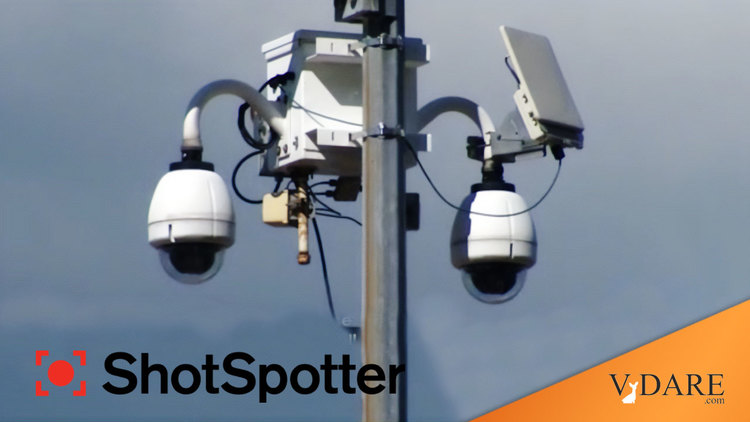![]()
Back in 1992, East Palo Alto was the Murder Capital of America, so a Stanford professor invented ShotSpotter to notify the cops when gunshots were heard.
So ShotSpotter provides another source of unpoliticized evidence that the return of Black Lives Matter led to blacks shooting each other in large numbers. Here’s a study of ShotSpotter and 911 calls in eight cities in 2020, with the baseline set to the week before the death of George Floyd. In the right-hand graph, the dashed vertical line is the beginning of the pandemic and the red vertical line is the death of Floyd.
As you can see, shots heard by the machinery were pretty stable until the beginning of the Racial Reckoning, after which shots heard immediately more than doubled over the next four weeks, then stabilized at maybe more than 75% of the third week of May until receding to only about 50% more shooty as cold weather set in later November 2020.
This graph is from:
Police violence reduces civilian cooperation and engagement with law enforcement∗
Desmond Ang,† Panka Bencsik,‡ Jesse Bruhn§ and Ellora Derenoncourt¶
September 20, 2021
Abstract
How do high-profile acts of police brutality affect public trust and cooperation with law enforcement? To investigate this question, we develop a new measure of civilian crime reporting that isolates changes in community engagement with police from underlying changes in crime: the ratio of police-related 911 calls to gunshots detected by ShotSpotter technology. Examining detailed data from eight major American cities, we show a sharp drop in both the call-to-shot ratio and 911 call volume immediately after the police murder of George Floyd in May 2020. Notably, reporting rates decreased significantly in both non-white and white neighborhoods across the country. These effects persist for several months, and we find little evidence that they were reversed by the conviction of Floyd’s murderer. Together, the results illustrate how acts of police violence may destroy a key input into effective law enforcement and public safety: civilian engagement and reporting.
It would seem most interesting to me that shots fired exploded as soon as Black Lives Matter was resuscitated at the end of May 2020, but the authors are more concerned with the decline in 911 calls. It looks like 911 calls for shots fired went up considerably in June 2020, although not as much as, you know, shots actually fired.
But then the public gave up around the Fourth of July. Was this because the Message of the Racial Reckoning—the cops are the Bad Guys while black men shooting guns are the Good Guys—finally got through to the masses?
Or is that when people realized this was just the Shootier New Normal?
Or did the enormous wave of firecrackers set off leading up to the Fourth of July have something to do with it? Last summer there was a series of bangs around the corner from me that sounded to me more like gunfire than firecrackers. So I grabbed my phone, dove on the floor, and called 911. I got into a discussion with the 911 operator over what chance it was really gunfire or just firecrackers. I explained I was down on the floor so evidently I was concerned. When asked for a percentage estimate of being gunshots, I said, “25%.” Evidently, that wasn’t high enough so I got shunted to a nonemergency line. But somebody else called in and gave a higher number because soon an LAPD helicopter was overhead.
I didn’t hear anything more about it, so I presume it was firecrackers.
[Comment at Unz.com]














